How I Do It: Encouraging AAC Implementation
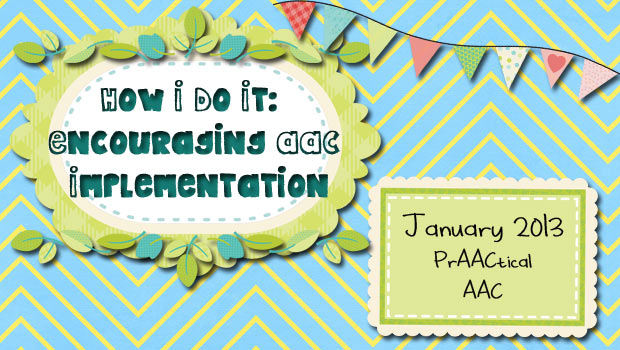
Nothing makes us happier than hearing AAC success stories. It’s thrilling to hear of folks who are using AAC tools and strategies to communicate effectively. We love hearing how their language develops and the positive changes that makes in their lives. It also makes us curious as to what made ‘this’ story a success story.
One of our goals for the new year was to give PrAACtical AAC followers a look into the experiences of professionals outside their own communities. Last week, we introduced AACtual Therapy, a series of guest posts by SLPs who are willing to give us a peek into their AAC therapy sessions. Today, we introduce How I Do It, a series in which we invite SLPs to share how they tackle common issues, tasks, or problems.
We’re excited to launch the series with a post from Lauren Enders, a clinician who supports the AAC community beyond her geographic reach on Facebook and Pinterest. We asked Lauren to talk a little about how she approaches the task of increasing implementation across settings and environments. Please join us in welcoming Lauren in her first guest post on PrAACtical AAC.
I am an ASHA certified Speech-Language Pathologist with a career-long passion for Augmentative and Alternative Communication (AAC) and Assistive Technology (AT). After spending years as a caseload clinician working with a variety of populations (including many students with complex support needs), I currently serve as a full-time AAC/AT consultant in a large county in Pennsylvania. I find the greatest need of professionals, support staff, and parents supporting AAC users to be learning how to teach their students to communicate with their systems. I teach about the importance of core language as well as provision models and strategies such as Aided Language Stimulation. I also help teams select motivating communication activities that give the students greater control and 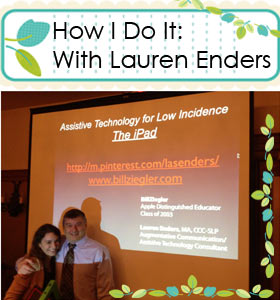 true educational participation through communication. In 2012, I created a large online resource providing resources on topics including AAC, AT, and Special Education (www.pinterest.com/lasenders). In the past year through social media, I have been thrilled to connect with many wonderful educators, therapists, and parents who are also focused on helping every individual find their voice.
true educational participation through communication. In 2012, I created a large online resource providing resources on topics including AAC, AT, and Special Education (www.pinterest.com/lasenders). In the past year through social media, I have been thrilled to connect with many wonderful educators, therapists, and parents who are also focused on helping every individual find their voice.
I could go on for pages and pages on the topic of training educators, therapists, support staff, and parents to successfully implement AAC systems; however, I’ll pare this post down to the basic building blocks. I’ll present as much as possible in a script, to make this as useful as possible for a turnaround training. Here goes…
INTRODUCTION:
“I have been in your shoes and have made the same implementation mistakes; therefore, I know that you have the ability to support your student. If I could learn, so can you! Most AAC implementation mistakes are made with the best of intentions and seem intuitive. We (teachers, SLPs, support staff, and parents) are rarely taught HOW to teach AAC, even when we are fortunate enough to take an AAC course. Therefore, there is no shame in not knowing what to do when we need to teach communication through AAC!”
THE ESSENTIAL TRAINING COMPONENTS: I find that an informal session where discussion and questions are encouraged puts team members at ease and makes the session more engaging, interactive, and valuable. IMPORTANT: Most often, a single training is not enough to get folks to a point where they feel they know how to proceed. I often present an initial training and then return to reiterate important concepts, answer questions, and most importantly, to model the concepts I taught.
1. CORE LANGUAGE EXPLANATION:
“As natural speakers, we communicate over 80% of what we say using CORE LANGUAGE, a set of 300 words we combine in new ways each time we speak. Without access to these words, (words like stop, go, more, like, etc.,) we could not express what is on our minds.”
a. “Here is what I believe is the golden handout of AAC implementation. It’s called Normal Language Development, Generative Language, and AAC by Gail M. VanTatenhove, PA, MA, CCC-SLP (http://www.vantatenhove.com/files/papers/LangDevelopmentIntervention/NormalLanguage&AAC.pdf).
I then paraphrase the following all-important information on the importance of core vocabulary from Gail’s NLDAAC handout
“The family, teacher, or therapist working with the child needs to have a vision of where they are going in terms of AAC and language development. Without this vision, development of an AAC system is too often driven by “immediate needs,” and the support team ends up continually scrambling to make yet another board or to program yet more vocabulary for yet another activity or event in the child’s life. What you often end up with is (1) an AAC system full of nouns, but deficit of language and/or (2) an AAC system that lacks a systematic organization of words. Plus, this cycle of board making and vocabulary programming is never ending and these boards and new now vocabulary are usually only used for a day, or week, or month. It does not build long-term, lifelong language skills.
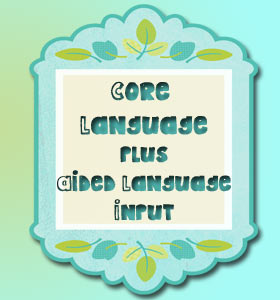 However, when the focus is on providing a planned set of high frequency, re-usable vocabulary, then you can concentrate on teaching language that provides the child with real communicative power. These kinds of words are called core vocabulary are they are the words that are useful across a broad number of events or activities and are needed throughout your entire life.”
However, when the focus is on providing a planned set of high frequency, re-usable vocabulary, then you can concentrate on teaching language that provides the child with real communicative power. These kinds of words are called core vocabulary are they are the words that are useful across a broad number of events or activities and are needed throughout your entire life.”
b. “Here is a YouTube video The Language Stealers by Michael Bryan Reed, Andrew Murray, Gemma Coils, and Robert McNicholas with animator Vivien Peach. This wonderful short (2:51) video emphasizes the importance of presenting core vocabulary as opposed to simply nouns and current curricular vocabulary.
(http://www.youtube.com/watch?v=Vib2__BDCXc).
c. “Let’s use the example of Columbus Day (USA, of course) as an example of selecting core vs. fringe words. “When we scramble to add pages to a child’s system with words like “Christopher Columbus”, “Nina”, “Pinta”, “Santa Maria”, the child won’t use those words again, until perhaps the next Columbus Day. However, if we use core words (i.e. “famous man found land”, “big boat”, “fast boat”, “long trip over water”, etc.), we are providing curricular content while also empowering the user with words that can be combined in novel ways to express various messages.
“Of course, using this approach doesn’t mean that we cannot add any fringe words. “Fringe” words like people’s names, favorite toys and favorite TV shows can become part of that individual’s “core” and can/should be incorporated to keep communication meaningful. I created the following vocabulary questionnaire along with my colleague Laurie McGowan, borrowing heavily from Janice Light’s preschool vocabulary questionnaire. (https://www.dropbox.com/s/fpudr0dh0wg6qtn/Vocabulary%20Questionnaire.doc)
d. “Our goal should be to provide every communicator with the tools to achieve SNUG – Spontaneous Novel Utterance Generation (as opposed to only giving them a bunch of pre-programmed sentences). Here is a nice handout from ASHA explaining this concept. (http://www.asha.org/public/speech/disorders/CommunicationDecisions/)”
2. IMPORTANCE OF MODELING/AIDED LANGUAGE INPUT EXPLANATION:
“How many speech models do you think typically developing kids hear in just an hour?” (The response is varied, but it’s always a sizeable number.) “Having these models along with the opportunity to babble and practice, making mistakes and overusing some words along the way, is how kids learn language. Now consider individuals using AAC systems. What models are they seeing of people communicating with pictures and words? (Most often, the answer is none.) So…what can we do? MODEL! We can complete vocabulary inventories, use core words, and create what seems to be the perfect vocabulary, but if we simply place the system in front of the child, they will almost never be able to use it. We must teach them how to communicate by showing them and expecting their responses.
“Though it’s on us to model, that it’s not so hard to do once you get the knack. Modeling of AAC doesn’t mean modeling EVERY WORD you say and therefore won’t force you to abandon all of your other students! Aided Language Input/ Aided Language Stimulation is a method of providing language input in the mode the child is using (pointing to picture symbols/words on their device or a reproduction).”
“Just as I can’t expect a student to learn language without models, I can’t expect them to learn how to teach AAC without models.” I then pull out a device and a no tech system and model how the technique is done.
RESOURCES I PROVIDE FOR AIDED LANGUAGE STIMULATION
(a.) Videos of Gail VanTatenhove using Aided Language Stimulation (http://www.youtube.com/playlist?list=PL5Ty2F6P1qol6W-QtoNlTcQoevi01sLXN)
(b.) Wonderful post and accompanying resources from PrAACticalaac.org entitled AACtual Progress: Learning to Use Aided Language Input (https://praacticalaac.org/strategy/aactual-progress-learning-to-use-aided-language-input/)
I work in a large suburban county with 13 school districts. I support students within every disability category, including a large number of students on the spectrum as well as a sizeable population with complex support needs. The majority of school districts fall primarily within the middle class range, with only two of the falling into a lower socioeconomic range. I find that the strategies I’ve described above work regardless of socioeconomic level or student disability type because they are effective with all AAC systems (no tech, low tech, mid tech, high tech) and do not require purchase of additional educational packages.
In the last few years, as I’ve honed the above method of supporting teams supporting AAC users (particularly emerging communicators), I have achieved greatest success when I work with the team more than once and provide clear, helpful models and resources. It has also been helpful when I allow team members to contact me with questions as they move forward.
Filed under: PrAACtical Thinking
Tagged With: aided language input, core vocabulary, How I Do It, Lauren Enders
This post was written by Carole Zangari

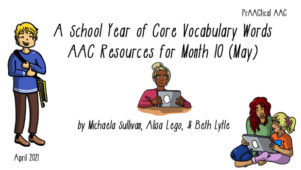
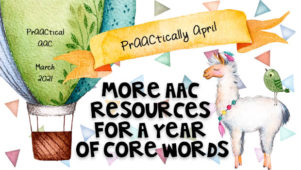
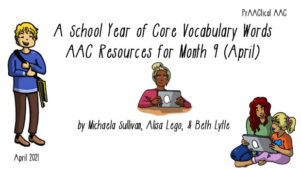
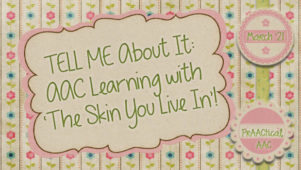
26 Comments
Great article, Lauren! I shared the link on my AAC FB page, http://www.facebook.com/HowKatieGotAVoice?ref=hl. And your Pinterest site is amazing! Thanks for all you do for kids with AAC needs. And thanks to PrAACtical AAC for another informative post. 🙂
Thank you so much, Pat! I hold your opinion in high regard, so your compliments and willingness to share my contributions are incredibly meaningful.
-Lauren
Great post Lauren – lots of good ideas and resources 🙂 Thanks!
Thank you so much, Jane! The tough part was choosing what to include in a short post!!! There’s so much to share and it’s all so important!
-Lauren
So true, definitely different style of writing about such important issues. You included the most relevant information and you can add more in future posts. But we agree, that is one of the hardest parts of ‘blogging’ for us.
Thanks, Jane! Glad to hear that my struggles weren’t unique to just me!! I wasn’t anticipating such a challenge! But, challenges are good. Now this blogging novice will have a little more experience next time. 🙂
Oops! I typed Jane. I need some rest! Thanks, Robin!!!
Haha. Not sure why my posts are HUGE!!!
Thank you Lauren for such wonderful and useful information. The information you provided is a great starting block to go from and everthing is organized so nice. Thank you for all of your hard work!
Melissa,
Thank you so much for taking the time to comment about my post! I’m thrilled that the concepts I chose to include had value and were clear enough to be useful!
-Lauren
Great article Lauren! Came back to re-read and access a few of the supporting links/documents. I found that Gail Van Tatenhove has moved the article you cited to the following address: http://www.vantatenhove.com/files/papers/LangDevelopmentIntervention/NormalLanguage&AAC.pdf
Thanks again!!!
Thank you so much for this VERY informative and useful post!
Danielle,
Just saw your comment over a year later! Oops! So glad the post was helpful. So sorry, but the handout I referenced from Gail is no longer available for download.
Lauren
Great post. Thanks!!!
Thank you so much for letting me know, Liz! Much appreciated!
Lauren
great post
Thank you, Charles!
Lauren
Thank you!!!!!
You’re most welcome, Natalie! So glad you found my post helpful!
Would love any advice for resources and training. A preschooler and I are embarking on our first foray into AAC. We’ve started core word of the week, and have been using a Big Mac, cheap talk 4, and GoTalk 9, along with fringe boards for weekly themes/books, etc. We Rae’s about to start using Snpa plus Core first, and would love any pointers. My guess is that we’ll start by modeling with the core words, but I am brand new to this side of speech language pathology!
Erin, modeling on his AAC system is absolutely the way to go. One of the most powerful things you can do to impact his learning is to get everyone using the AAC when they talk to him. It takes a good deal of effort to teach the key communication partners and be there to inspire and encourage them to model all throughout the day, but it is SO vital to learning. I would focus on that for the first several weeks or even months so that all of you get familiar with his new AAC. Parents have told me that it is actually way easier for them to model with a more robust set of core words than it is with a smaller set of under 30 words. I could write a book on other things about implementation, but modeling is great place to start if you are new to all of this. If the classroom is open to implementing in a more cohesive manner, take a look at the program Lori Wise and I developed (http://bit.ly/TELLmeOverview). In any event, stay in touch and reach out whenever you need some help or ideas. We’re on FB, too, if that is easier. 🙂 Good luck with your little cutie!
So glad it was helpful. Follow Lauren on Pinterest, she has really great info.
Thank you, Robin! 🙂
-Lauren